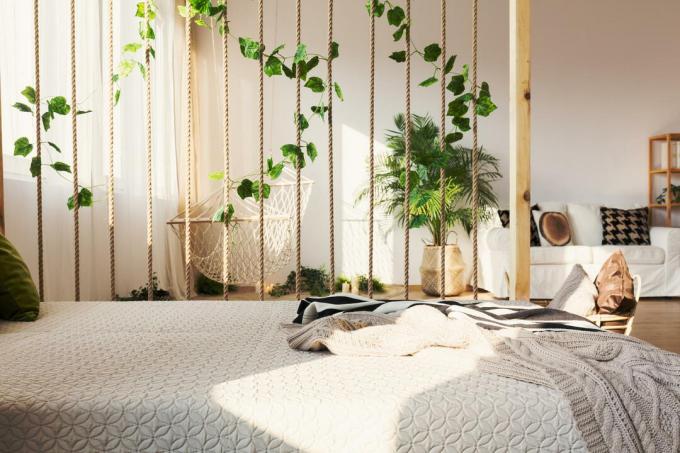Ivy does not necessarily have to grow outside, it also feels at home indoors. Here you can find out everything about planting and caring for ivy as a houseplant.

Even if you ivy (Hedera helix) tends to think of overgrown ancient walls or romantic seating areas in the countryside, the plant also has a lot to offer indoors. Especially in large stairwells or in the hallway there are countless possibilities for staging the ivy. Simply let your imagination run wild to integrate the evergreen plant into your home.
Actually, ivy is a typical garden plant. On closer inspection, it can be found everywhere: on spooky ruins, in the sparse deciduous forest or in the neighbor's garden. But why not in your own bathroom? Or on a climbing net right next to your bed? Ivy is a beautiful houseplant that can be used in many ways. It is often offered as a hanging plant. Naturally, however, it has particular potential as a climbing plant. You can plant veritable green walls along railings, lattices or specially built climbing aids, which improve the indoor climate and also clean the air.
contents
- The right choice of variety for ivy as a houseplant
- Ivy as a houseplant: The ideal location in the house
- Plant ivy as a houseplant
- Caring for ivy as a houseplant
The right choice of variety for ivy as a houseplant
You will find ivy for the room in the most diverse variations, because here you also have a free choice among the non-hardy species. The Algerian ivy (Hedera algeriensis), for example, sets pretty accents with its beautiful leaves patterned in white and green tones. Also various variegated varieties such as Hedera helix 'Gold Hummingbird' or Hedera helix ‘Eva’ are quite impressive. However, these species and varieties with a relatively high proportion of white in the leaves prefer a light location. For those who prefer it simple and discreet, the classic common ivy (Hedera helix) with its dark green leaves is the right choice. You can also plant it in darker corners.
Ivy as a houseplant: The ideal location in the house
Ivy is relatively undemanding as a houseplant. As for the location, it does quite well with not too much light. The only thing you should avoid is direct sunlight. The plant prefers places with high humidity. If the air is too dry, the plant quickly suffers spider mites. Maybe you still have a spot in the bathroom? Otherwise, you can regularly spray the plants with a little lime-free water to protect them from drought. The ivy will thank you for the small shower.
Plant ivy as a houseplant
If you have now found a suitable place and a beautiful plant, then it's time to pot. It is best to use a universal soil of organic quality as the substrate, such as the peat-free one Plantura organic universal soil. The pot should be big enough and have a drainage hole for excess water. You can of course use a cachepot for hanging plants. If the pot is too small for the ivy, you will notice this from the roots that stick out below and try to explore new terrain. Choose a pot that is a few inches larger in diameter and transplant the plant. The best time to do this is spring, when the plant starts the new season. Repotting is usually required every one to two years. Everything else on the topic plant ivy find out here.
Summary of planting ivy as a houseplant:
- There is a wide range of ivy species and varieties for indoor use
- Place plants with light-colored leaves in a bright location, dark-leaved plants can also cope with less light
- Choose a location with high humidity
- As a substrate universal earth - for example Plantura organic universal soil - use
- Use pot with drainage hole
- Repot the plant in spring

Caring for ivy as a houseplant
As a houseplant, ivy must of course be watered regularly. However, always let the soil dry out on the surface. An occasional dose of fertilizer can also be very helpful to stimulate growth. A gift from us Plantura organic universal fertilizer with a long-term effect in the spring saves a lot of work here. In winter, the ivy also needs a winter break. During this time, around November to February, you should water your plant more cautiously and no longer fertilize it. The ivy likes to stand a little cooler at this time. Place it in a bright stairwell or a similar place so that it does not get warmer than 15 °C. Everything else about care of ivy find out here.
If you have pets, keep in mind that ivy is poisonous to them and could potentially pose a threat. In this article you will learn more about how poisonous ivy is.



